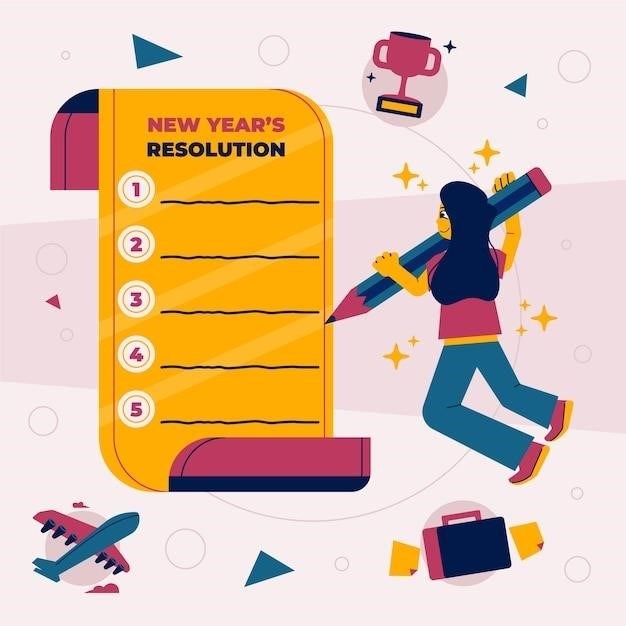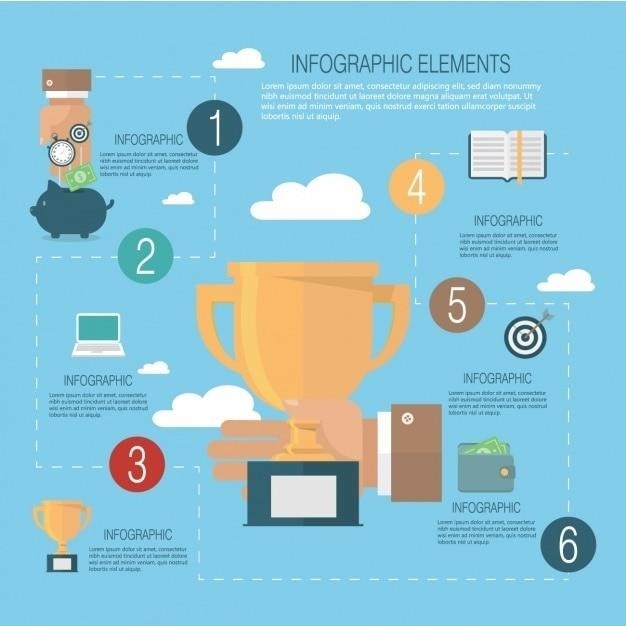Gagné’s Nine Events of Instruction⁚ A Framework for Effective Teaching
Robert Gagné’s Nine Events of Instruction is a powerful framework that has been adopted by educators and trainers around the world. This model has proven to be an effective approach for promoting deeper understanding, improved knowledge retention, and successful skill acquisition. The nine events include gaining attention, informing learners of objectives, stimulating recall of prior learning, presenting the content, providing learning guidance, eliciting performance, providing feedback, assessing performance, and enhancing retention and transfer.
Introduction
In the realm of instructional design, Robert Gagné’s Nine Events of Instruction stands as a prominent framework for creating effective learning experiences. This model, rooted in the principles of cognitive psychology, outlines a systematic approach to teaching that emphasizes the importance of engaging learners, establishing clear learning goals, and providing ample opportunities for practice and feedback. By applying these nine events, educators can create instructional materials and strategies that promote deeper understanding, enhance knowledge retention, and facilitate the transfer of learned skills to real-world contexts. The Nine Events of Instruction, also known as Gagné’s Conditions of Learning, are a set of instructional design principles developed by psychologist Robert Gagné. These conditions outline a sequence of events that enhance the learning process and promote effective instruction. Gagné’s theory of instructional learning offers a framework for educators to design and deliver instruction that aligns with how individuals learn.
Overview of Gagné’s Nine Events of Instruction
Gagné’s Nine Events of Instruction is a model that emphasizes a sequential approach to learning, ensuring that learners are adequately prepared to engage with new information and develop desired skills. This model is based on the idea that effective learning involves a series of carefully planned steps that guide learners through the process of acquiring knowledge and skills. It proposes that instruction should be structured in a way that addresses the different stages of learning, from gaining attention to enhancing retention and transfer. Gagné’s Nine Events of Instruction outlines a systematic approach to instructional design based on how information is processed in the human mind. The nine events are⁚ gain attention, inform learners of objectives, stimulate recall of prior learning, present the content, provide learning guidance, elicit performance, provide feedback, assess performance, and enhance retention and transfer. Each of the nine events of instruction is highlighted below, followed by sample methods to help implement the events in your own instruction.
The Nine Events
Gagné’s Nine Events of Instruction are divided into three segments⁚ preparation, instruction and practice, and assessment and transfer. The first three events, gaining attention, informing learners of objectives, and stimulating recall of prior learning, are crucial for setting the stage for learning. The next four events, presenting the content, providing learning guidance, eliciting performance, and providing feedback, focus on the actual instruction and practice. The final two events, assessing performance and enhancing retention and transfer, emphasize the importance of evaluating learning and ensuring that learners can apply what they have learned in new situations. Each of these events is essential for creating a learning environment that is both effective and engaging.

Gaining Attention
The first step in Gagné’s Nine Events of Instruction is to gain the attention of the learners. This is crucial because it sets the stage for learning and motivates learners to engage with the material. There are many ways to gain attention, such as asking a thought-provoking question, showing a relevant video clip, or using a captivating image or sound. The key is to choose a method that is appropriate for the topic and audience, and that will pique their interest and curiosity. By effectively gaining attention, you can create a more receptive learning environment and increase the likelihood that learners will retain the information presented.
Informing Learners of Objectives
Once you have captured the learners’ attention, the next step is to clearly inform them of the learning objectives. This means outlining what they should be able to do or know by the end of the lesson. Clear and specific objectives provide learners with a sense of purpose and direction, helping them to focus their attention and effort. It is important to state the objectives in a way that is understandable and meaningful to the learners. For example, instead of saying “Students will learn about the causes of the American Revolution,” you could say “Students will be able to identify and explain the three main causes of the American Revolution.” By clearly stating the objectives, you can ensure that learners understand what is expected of them and that they are working towards a specific goal.
Stimulating Recall of Prior Learning
Before introducing new material, it’s crucial to activate learners’ prior knowledge. This step helps learners connect new information to what they already know, making it more meaningful and easier to understand. You can stimulate recall of prior learning through various techniques, such as asking questions related to the topic, showing a relevant image or video, or having learners complete a short pre-assessment. For example, if you’re teaching a lesson on photosynthesis, you might ask learners to recall what they know about plants, light, and energy. By connecting new learning to existing knowledge, learners can build a stronger understanding of the subject matter and retain the information for a longer period.
Presenting the Content
This event involves delivering the new information to learners in a clear and engaging manner. The presentation should be organized logically, using appropriate visuals, examples, and real-world applications to make the content relatable and understandable. Consider the learners’ learning styles and preferences when choosing presentation methods. For example, some learners may prefer visual aids, while others may benefit from hands-on activities or group discussions. The key is to provide the information in a way that is both informative and engaging, keeping learners actively involved in the learning process. This step lays the foundation for deeper understanding and retention of the material.
Providing Learning Guidance
This event involves offering learners support and direction as they work through the content. It’s about providing them with the tools and strategies they need to successfully apply the newly acquired knowledge or skills. This might involve providing clear instructions, offering examples and practice exercises, or facilitating group work where learners can collaborate and learn from each other. Effective guidance also includes providing feedback and encouragement, helping learners identify their strengths and areas for improvement. The goal is to empower learners to become independent learners, able to apply what they’ve learned in different contexts.
Eliciting Performance
This event is all about actively engaging learners in applying what they’ve learned. It’s not enough to simply present information; learners need to demonstrate their understanding and mastery through hands-on activities. This could involve solving problems, completing assignments, participating in discussions, or even creating something new based on the acquired knowledge. The key is to create opportunities for learners to actively use their knowledge and skills in a meaningful way. This step helps learners solidify their understanding and develop a deeper sense of ownership over the material.
Providing Feedback
Feedback is essential for learners to understand their progress and identify areas for improvement. It allows them to see how well they’re grasping the material and what they need to work on further. Effective feedback should be timely, specific, constructive, and focused on the learning objectives. It should not only highlight errors but also provide guidance on how to correct them. Learners need to understand what they did well and where they need to improve. This feedback should be delivered in a way that is helpful and encouraging, promoting a growth mindset and encouraging learners to continue their efforts.
Assessing Performance
Assessing performance is crucial to determine if learning objectives have been achieved. This involves evaluating learners’ understanding of the material and their ability to apply it in real-world situations. Assessment methods can range from traditional tests and quizzes to more creative approaches like projects, presentations, or simulations. The key is to choose assessments that are aligned with the learning objectives and provide meaningful feedback to learners. This step helps educators understand if their instruction was effective and identify areas where adjustments might be needed to better support learners’ needs. By analyzing performance data, educators can ensure that learners are progressing towards mastery and achieving the desired learning outcomes.
Enhancing Retention and Transfer
The final event in Gagné’s model focuses on maximizing long-term retention and the ability to apply knowledge and skills in new situations. This involves strategies that promote meaningful learning and encourage learners to actively engage with the material. Techniques like spaced repetition, retrieval practice, and applying knowledge in different contexts can enhance retention. Encouraging learners to connect new information to existing knowledge and to make connections between concepts promotes deeper understanding and improves the ability to transfer learning. This step ensures that learners retain what they have learned and can effectively apply it in real-world situations, ultimately achieving the desired learning outcomes.
Application of Gagné’s Events in Different Learning Environments
Gagné’s Nine Events of Instruction are adaptable to various learning environments, from traditional classrooms to online learning platforms. In a classroom setting, teachers can use interactive activities, real-world examples, and group discussions to gain attention and stimulate recall of prior knowledge. In online learning, multimedia elements like videos, simulations, and interactive quizzes can be employed to present content and provide feedback. The events can be integrated into blended learning approaches, combining online resources with face-to-face instruction. By adapting the events to specific contexts, educators can ensure that learning is engaging, effective, and tailored to the needs of diverse learners.
Gagné’s Nine Events of Instruction provide a comprehensive framework for designing effective instruction that considers the cognitive processes involved in learning. By systematically applying these events, educators can create engaging and meaningful learning experiences that promote deep understanding, lasting retention, and successful skill acquisition. The framework’s adaptability to diverse learning environments makes it a valuable tool for educators across disciplines and settings. While the events offer a structured approach to teaching, it’s essential to remember that they should be implemented flexibly and creatively, tailored to the specific needs of learners and the content being taught.
